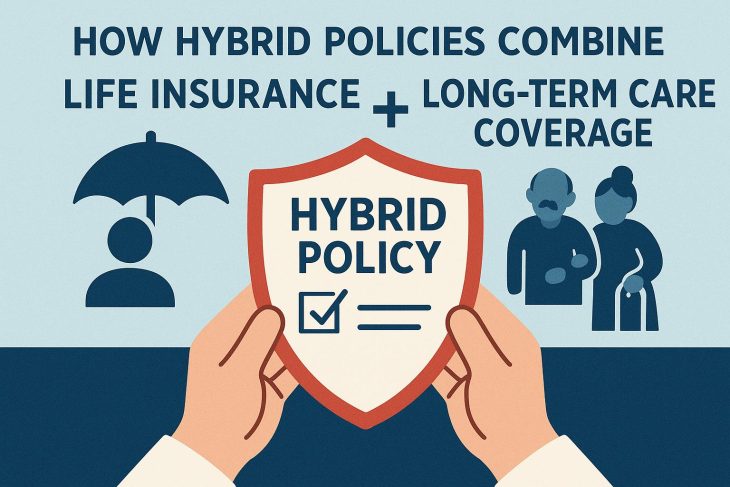
Understanding Hybrid Policies
Hybrid policies, which blend life insurance and long-term care coverage, are increasingly popular in the insurance market. These policies offer a unique solution to two significant financial concerns: securing life insurance and preparing for potential long-term care needs. This integration can be particularly attractive to individuals seeking comprehensive coverage under one plan.
Key Components of Hybrid Policies
Traditional life insurance provides a death benefit, while long-term care insurance covers expenses related to extended caregiving needs, such as those arising from chronic illnesses or disabilities. Hybrid policies combine these two features, offering a death benefit along with the option to use a portion of the policy’s value for long-term care expenses.
Death Benefit: Like typical life insurance, hybrid policies provide a death benefit to beneficiaries upon the policyholder’s passing. If the policyholder does not require long-term care, the full death benefit is paid out.
Long-Term Care Benefits: These policies allow policyholders to access long-term care benefits if needed, reducing the death benefit by the amount used for care. This feature can cover costs for nursing home care, home healthcare, or assisted living facilities.
Advantages of Hybrid Policies
Flexibility and Security: One of the primary advantages of hybrid policies is flexibility. Policyholders can address long-term care needs without sacrificing life insurance benefits for their beneficiaries. This dual functionality provides a sense of security and financial planning efficiency.
Cost-Effective Solution: Compared to purchasing separate life insurance and long-term care policies, hybrids can be more cost-effective, eliminating the need for multiple premiums. Additionally, the premiums are generally locked in, preventing increases common in standalone long-term care policies.
By offering these dual benefits in a single package, hybrid policies potentially simplify managing insurance needs. Many individuals find comfort in knowing that these policies can adapt to life’s uncertainties, whether it involves using long-term care benefits in one’s later years or leaving a financial legacy for heirs. The all-encompassing nature means that hybrid policies address current and future financial responsibilities under a unified coverage plan, avoiding the complexity and potential higher cumulative costs related to maintaining two separate insurance policies.
Potential Considerations
While hybrid policies offer notable benefits, potential policyholders should consider certain aspects before making a decision. It’s essential to evaluate if the combined coverage aligns with personal financial goals and healthcare needs.
Lump-Sum Premiums: Many hybrid policies require a substantial one-time premium payment, which can be a financial hurdle for some. However, certain policies offer flexible payment options, such as spreading payments over several years. This flexibility can make hybrid policies more accessible, particularly for those concerned about managing a large upfront financial commitment.
Reduced Death Benefit: Using long-term care benefits reduces the available death benefit, impacting the amount left to beneficiaries. Prospective buyers should assess this trade-off based on individual circumstances. It’s important to evaluate how potential future healthcare needs may affect the policy’s primary intent, which is to provide a death benefit to one’s heirs.
In scenarios where long-term care becomes a necessity, policyholders reduce the death benefit proportionally to the caregiving expenses withdrawn. This aspect calls for a careful consideration of the amount intended for loved ones and whether it suffices for their future needs.
There is also the possible limitation of choice when selecting care services under a hybrid policy, as some insurers may impose restrictions on which service providers can be used. Policyholders should confirm whether their preferred healthcare providers are covered under their policy terms to avoid any potential issues at the time of care.
Choosing the Right Policy
Selecting the right hybrid policy involves thorough research and understanding specific policy terms. Engaging with a knowledgeable insurance advisor can offer valuable insights tailored to personal needs. An experienced advisor can help clarify complex policy documents, explaining nuances and ensuring the policy’s benefits align with personal goals.
It is beneficial for individuals to compare multiple hybrid policy offers from different insurers, understanding their custom features and riders. Riders are options that provide additional benefits or options within the policy. Each insurer might have offerings that suit different preferences or financial strategies. A detailed comparison is crucial to ensure one’s decision is based on comprehensive information and not just initial impressions or advertised advantages.
Individuals should also consider their long-term financial trajectory. Examining current health, lifestyle, potential future risks, and planned retirement can provide a framework for evaluating how much long-term care coverage might be realistically needed. These considerations will aid in selecting a policy that appropriately balances risk protection with legacy planning.
For more information on hybrid policies and other insurance options, consider visiting sites that specialize in insurance brokerage services or consulting directly with certified insurance professionals.
Conclusion
Hybrid policies represent an innovative approach to insurance, combining life coverage with long-term care benefits. Balancing these elements requires careful consideration of personal financial goals and potential future needs. These policies cater to a growing demographic need, fitting the lifestyle and financial outlook of many modern families.
Ultimately, these policies can offer peace of mind by addressing two vital aspects of financial planning with a single, cohesive solution. Potential policyholders should weigh the advantages of having an integrated policy against the need for potentially reducing death benefits. Such considerations help in selecting a solution that truly meets one’s financial security and legacy objectives. While the path to choosing a hybrid policy can be intricate, it provides an opportunity to simultaneously secure life’s uncertainties and the unforeseen challenges that may accompany aging.
This article was last updated on: September 23, 2025
